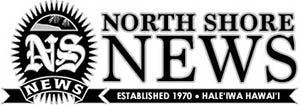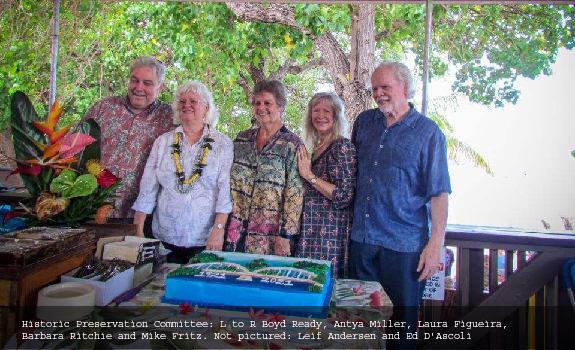By Antya Miller
What is Historic About Hale‘iwa? The State bypass signs direct people to “historic Hale‘iwa,” but there is little information in the town to tell people WHY it is historic. Recently, the North Shore Chamber’s Historic Preservation Committee installed three more plaques at the K. Nishimura Tailor, Ishimoto Store and Surf N Sea historic buildings to address this question. The Chamber secured grant monies from the Hawai‘i Tourism Authority, the National Trust for Historic Preservation, and the Atherton Family Foundation to implement a signage project that interprets the history of Hale‘iwa Town. The Chamber, also known as Hale‘iwa Main Street (HMS), has worked since 1984 to preserve our historic buildings and history in support of the City’s Hale‘iwa Special Design District ordinance.
There are three components to the project, one completed and two in progress:
- The Chamber’s Hale‘iwa Walking Tour brochure/ map of the historic buildings, revised and reprinted;
- Plaques on the historic buildings protected by the Hale‘iwa Special Design District; and
- Four interpretive kiosks at key locations spaced throughout town next to parking lots and/or hightraffic areas.
The first Walking Tour was “Lucky” Cole’s idea, using Meryl Andersen’s historical information, Ilona Hemperly’s sketches of the historic buildings, and Jo Jean Schieve’s capable desktop publishing skills and was printed in 1998. The updated 2020 map was completed and reprinted and is now available at the Chamber’s office. To accomplish the Walking Tour Map and other components of the project, tons of research had to be done starting with Meryl Andersen collecting stories from the old timers in the 1960s.
Since then, the bulk of research has been done by Barbara Ritchie and Rick Rogers (deceased in 2020), who have spent countless hours going to the Bureau of Conveyances, State Archives, the State and Hamilton Libraries, doing oral histories and internet searches, etc. Sanborn Fire Insurance Maps are a big help in finding when a building was built, but in rural communities like ours, Sanborn maps weren’t done until 1927 so other methods must be employed to determine the built date.
In researching the Morioka Building, aka The Growing Keiki, the North Shore News was the source of information regarding Beverly Fettig, who started the first art gallery there in 1963. Oral histories require the tenacity of a detective and the social skills of a diplomat. One needs to figure out the family relationships, who to interview, how to get in touch with them, who is still alive that grew up knowing the buildings, and it all requires loads of time. Our kupuna, many in their 90s, have been very gracious and generous in helping us and working with Barbara Ritchie, our committee member and masterful oral historian.
To date, we have written 15 building plaque narratives, installed seven, eight are being made, and six require property owners’ permission. They are manufactured in Pennsylvania and are just like the plaques in Chinatown’s historic district. Each plaque’s narrative provides a short history of a building and its role in the development of Hale‘iwa town. The Historic Preservation Committee Chair, Antya Miller explains, “These signs will complement the Chamber’s Walking Tour or stand on their own, in telling Haleiwa’s story to residents and visitors alike, so they can learn about Haleiwa’s unique history and character.”
Four kiosks are planned and will be placed strategically throughout the town. Each one will have a map showing Haleiwa’s buildings or sites and the viewer’s location. The other side will be a topic of the town’s history with photos:
Kiosk 1 Hale‘iwa and the Plantation Era, at the Chamber’s Visitor and Business Services Center;
Kiosk 2 Ancient Waialua, at the Waialua Courthouse;
Kiosk 3 Kingdom and Missionary Period, at Lili‘uokalani Protestant Church;
Kiosk 4 Surfing Era, at Hale‘iwa Beach Park.
The first kiosk has been ordered. These are public educational signs and will only have sponsors’ logos on them; no advertising. We have been working with the Dept. of Planning and Permitting since 2017 and have received written consent from them for the design of the kiosks. Property owners need to give permission to the Chamber for the kiosk placement on their property and approve the proposed history.
This project is the culmination of 25 years of planning and thousands of hours of volunteer time by the Chamber and its Historic Preservation Committee. We owe a great deal to the current committee members, many who came before them and the kupuna and others in the community who have helped us piece together the histories of these buildings. Mahalo nui to all of you.



